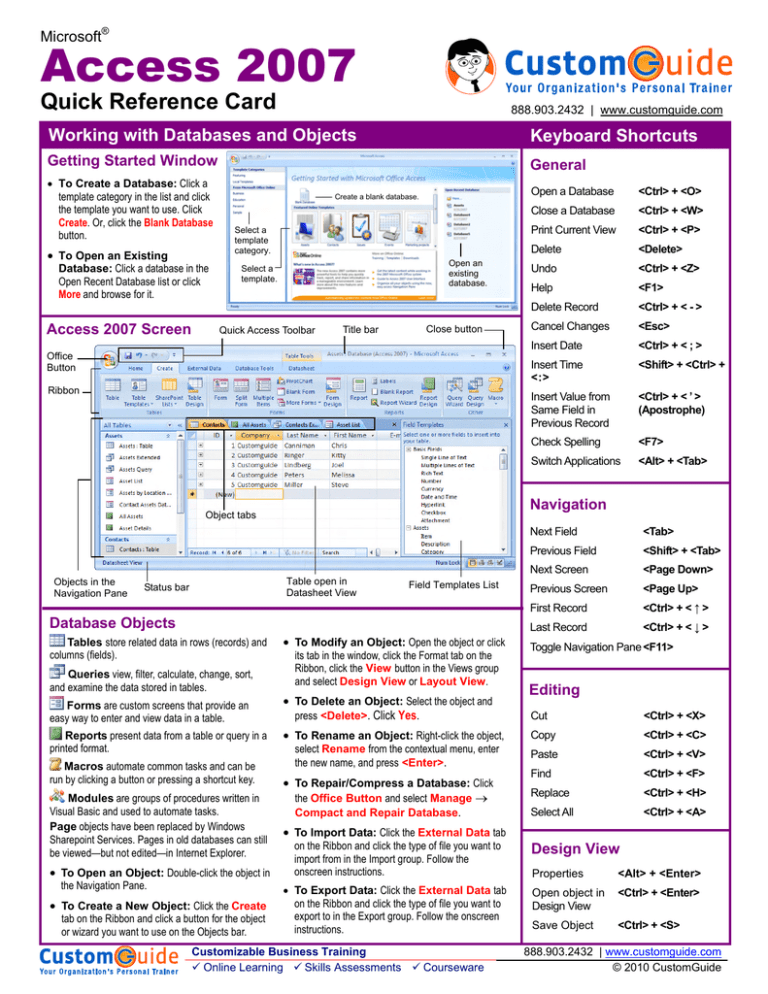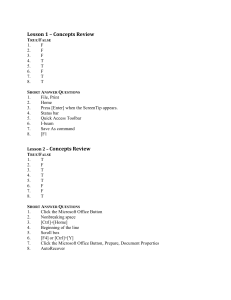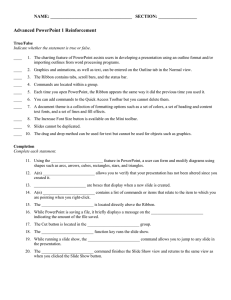Access 2007 Quick Reference Card Working with Databases and Objects Keyboard Shortcuts
advertisement

Microsoft® Access 2007 Quick Reference Card 888.903.2432 | www.customguide.com Working with Databases and Objects Keyboard Shortcuts Getting Started Window General • To Create a Database: Click a template category in the list and click the template you want to use. Click Create. Or, click the Blank Database button. • To Open an Existing Database: Click a database in the Open Recent Database list or click More and browse for it. Access 2007 Screen Create a blank database. Select a template category. Open an existing database. Select a template. Quick Access Toolbar Title bar Close button Office Button Ribbon Table open in Datasheet View Status bar Field Templates List Database Objects Tables store related data in rows (records) and columns (fields). Queries view, filter, calculate, change, sort, and examine the data stored in tables. Forms are custom screens that provide an easy way to enter and view data in a table. Reports present data from a table or query in a printed format. Macros automate common tasks and can be run by clicking a button or pressing a shortcut key. Modules are groups of procedures written in Visual Basic and used to automate tasks. Page objects have been replaced by Windows Sharepoint Services. Pages in old databases can still be viewed—but not edited—in Internet Explorer. • To Open an Object: Double-click the object in the Navigation Pane. • To Create a New Object: Click the Create tab on the Ribbon and click a button for the object or wizard you want to use on the Objects bar. <Ctrl> + <O> Close a Database <Ctrl> + <W> Print Current View <Ctrl> + <P> Delete <Delete> Undo <Ctrl> + <Z> Help <F1> Delete Record <Ctrl> + < - > Cancel Changes <Esc> Insert Date <Ctrl> + < ; > Insert Time <:> <Shift> + <Ctrl> + Insert Value from Same Field in Previous Record <Ctrl> + < ’ > (Apostrophe) Check Spelling <F7> Switch Applications <Alt> + <Tab> Navigation Object tabs Objects in the Navigation Pane Open a Database • To Modify an Object: Open the object or click its tab in the window, click the Format tab on the Ribbon, click the View button in the Views group and select Design View or Layout View. • To Delete an Object: Select the object and press <Delete>. Click Yes. • To Rename an Object: Right-click the object, select Rename from the contextual menu, enter the new name, and press <Enter>. • To Repair/Compress a Database: Click the Office Button and select Manage → Compact and Repair Database. Next Field <Tab> Previous Field <Shift> + <Tab> Next Screen <Page Down> Previous Screen <Page Up> First Record <Ctrl> + < ↑ > Last Record <Ctrl> + < ↓ > Toggle Navigation Pane <F11> Editing Cut <Ctrl> + <X> Copy <Ctrl> + <C> Paste <Ctrl> + <V> Find <Ctrl> + <F> Replace <Ctrl> + <H> Select All <Ctrl> + <A> • To Import Data: Click the External Data tab on the Ribbon and click the type of file you want to import from in the Import group. Follow the onscreen instructions. • To Export Data: Click the External Data tab on the Ribbon and click the type of file you want to export to in the Export group. Follow the onscreen instructions. Customizable Business Training 9 Online Learning 9 Skills Assessments 9 Courseware Design View Properties <Alt> + <Enter> Open object in Design View <Ctrl> + <Enter> Save Object <Ctrl> + <S> 888.903.2432 | www.customguide.com © 2010 CustomGuide Working with Tables Creating Table Relationships Linking Tables tells Access how two tables are related to each other. The fields that you use to link two tables must contain the same concept in two different tables. A primary key field from one table is often used when linking two tables. 1. Click the Datasheet tab on the Ribbon and click the Relationships button in the Relationships group. 2. If necessary, click the Show Table button in the Relationships group on the Design tab. In the Show Table window, select a table you want to link, click the Add button, and repeat for each table. Click Close. 3. Drag a field from one table and drop it on the related field in the second table. (Optional) Check the Enforce Referential Integrity box. Click Create. Field Data Types Data Type Text (Default) Memo Number Date/Time Currency AutoNumber Yes/No OLE Object Hyperlink Lookup Wizard Working with Table Data • Database information can be directly added and modified from tables and some queries and forms. • To Add a Field to a Table: Enter data in the cell below the Add New Field column header. Or, click and drag a field from the Field Templates pane to the table (to display the Field Templates pane, click the Datasheet tab on the Ribbon and click the New Field button in the Fields & Columns group). Attachment Description Stores text, numbers, or a combination of both, up to 255 characters long. Stores long text entries—up to 64,000 characters long. Stores numbers that can be used in calculations. Stores dates, times, or both. Stores numbers and symbols that represent money. Automatically fills in a unique number for each record. Stores only one of two values, such as Yes or No. Stores objects created in other programs, such as a graphic, Excel spreadsheet, or Word document. Stores clickable links to Web pages on the Internet or files on a network. A wizard that helps you create a field whose values are selected from another table, query, or list of values. Allows you to attach files and images to your database. Working with Queries The Design Query Window To add a field to the query, click and drag it from the table down to the design grid. The queried tables appear here. You can also link tables. • To Add a New Record: Enter data in the bottom row of the table. Record selector Start adding a new record here. • To Select a Record: Click the Record selector to the left of the record. • To Delete a Record: Select the record, click the Home tab on the Ribbon and click the Delete button in the Records group. Click Yes. • To Spell Check: Click the Home tab on the Ribbon and click the Spelling button in the Records group. • To Find Information: Place the cursor in the field that contains the value you want to search for, click the Home tab on the Ribbon and click the Find button in the Find group or press <Ctrl> + <F>. Type the value you want to search for in the Find What box and click Find Next. • To Replace Information: Place the cursor in the field that contains the value you want to replace, click the Home tab on the Ribbon and click the Replace button in the Find group or press <Ctrl> + <H>. Type the value you want to search for in the Find What box and the new value in the Replace With box. Click Find Next until you’ve found what you’re looking for, then click Replace or Replace All to replace every instance of the value. • To Sort Information: Place the cursor in the field that you want to sort by, click the Home tab and click either the Ascending or Descending button in the Sort & Filter group. • To Filter Information: Place the cursor in the field that contains the values you want to filter by, click the Home tab on the Ribbon and click the Filter button in the Sort & Filter group. Check the boxes for the values you want to filter for. Sort order Show results Criteria rows Design grid • To Create a Select Query: Click the Create tab on the Ribbon and click the Query Wizard button in the Other group. Click Simple Query Wizard and click OK. Follow the onscreen instructions to select the fields you want to use from the desired tables and create the query. If you want to filter records, view the query in Design view and enter the criteria in the Criteria row. • To Switch Views: Click the Home tab on the Ribbon and click the View button in the Views group. • To Summarize Values: Open the Query in Datasheet View, click the Home tab on the Ribbon and click the Totals button in the Records group. Click the list arrow in a column in the Total row in the query select a calculation type (Sum, Average, etc.). Criteria Example “London” Between 1/1/00 and 12/31/00 NOT "USA" or <> "" Like “S*” IS NULL IS NOT NULL >100 Description Displays records where the field equals “London.” Displays records where the date is between 1/1/00 and 12/31/00. • To Remove a Filter: Click the Toggle Filter button in the Sort & Displays records where the field does not contain the Filter group. text "USA" and is not blank. Displays records where the field text starts with an “S.” • To Change a Field’s Data Type: Select the field you want to Displays records where the field is blank. change, click the Datasheet tab on the Ribbon, and click the Data Displays records where the field is not blank. Type list arrow in the Data Type & Formatting group. Select a data type. Displays records whose field value is greater than 100. Customizable Business Training 888.903.2432 | www.customguide.com 9 Online Learning 9 Skills Assessments 9 Courseware © 2010 CustomGuide

